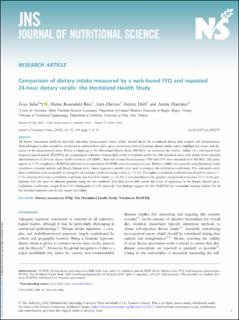| dc.contributor.author | Sabir, Zoya | |
| dc.contributor.author | Rosendahl-Riise, Hanne | |
| dc.contributor.author | Dierkes, Jutta | |
| dc.contributor.author | Dahl, Helene | |
| dc.contributor.author | Hjartåker, Anette | |
| dc.date.accessioned | 2023-01-13T14:11:32Z | |
| dc.date.available | 2023-01-13T14:11:32Z | |
| dc.date.created | 2022-12-04T14:05:18Z | |
| dc.date.issued | 2022 | |
| dc.identifier.issn | 2048-6790 | |
| dc.identifier.uri | https://hdl.handle.net/11250/3043442 | |
| dc.description.abstract | All dietary assessment methods inevitably introduce measurement errors, which should ideally be considered during data analysis and interpretation. Methodological studies should be conducted to address how well a given assessment method captures dietary intake and to highlight the extent and direction of the measurement error. Within a subgroup of the Hordaland Health Study (HUSK3), we examined the relative validity of a web-based food frequency questionnaire (WebFFQ) by comparing its estimates of mean daily intake of nutrients and foods with estimated mean daily intakes from repeated administrations of 24-hour dietary recall interviews (24-HDRs). Men and women born between 1950 and 1951 were recruited from HUSK3. The participants (n = 67) completed a WebFFQ and three non-consecutive 24-HDRs over the course of a year. Relative validity was assessed using Spearman's rank correlation, crosstab analysis and Bland–Altman plots. Linear regression models were used to compute the calibration coefficients. The estimated correlation coefficients were acceptable or strong for all nutrients and foods except iodine (rs = 0⋅19). The highest correlation coefficient was found for juice (rs = 0⋅71), whereas the lowest correlation coefficient was found for iodine (rs = 0⋅19). Cross-classification by quartiles categorised more than 72 % of the participants into the same or adjacent quartiles using the two methods. Few data points fell outside the limits of agreement in the Bland–Altman plots. Calibration coefficients ranged from 0⋅10 (wholegrain) to 0⋅81 (alcohol). Our findings suggest that the WebFFQ has reasonable ranking abilities for all the included nutrients and foods, except for iodine. | en_US |
| dc.language.iso | eng | en_US |
| dc.publisher | Cambridge University Press | en_US |
| dc.rights | Navngivelse 4.0 Internasjonal | * |
| dc.rights.uri | http://creativecommons.org/licenses/by/4.0/deed.no | * |
| dc.title | Comparison of dietary intake measured by a web-based FFQ and repeated 24-hour dietary recalls: the Hordaland Health Study | en_US |
| dc.type | Journal article | en_US |
| dc.type | Peer reviewed | en_US |
| dc.description.version | publishedVersion | en_US |
| dc.rights.holder | Copyright 2022 the authors | en_US |
| dc.source.articlenumber | e98 | en_US |
| cristin.ispublished | true | |
| cristin.fulltext | original | |
| cristin.qualitycode | 1 | |
| dc.identifier.doi | 10.1017/jns.2022.97 | |
| dc.identifier.cristin | 2088268 | |
| dc.source.journal | Journal of Nutritional Science (JNS) | en_US |
| dc.identifier.citation | Journal of Nutritional Science (JNS). 2022, 11, e98. | en_US |
| dc.source.volume | 11 | en_US |

